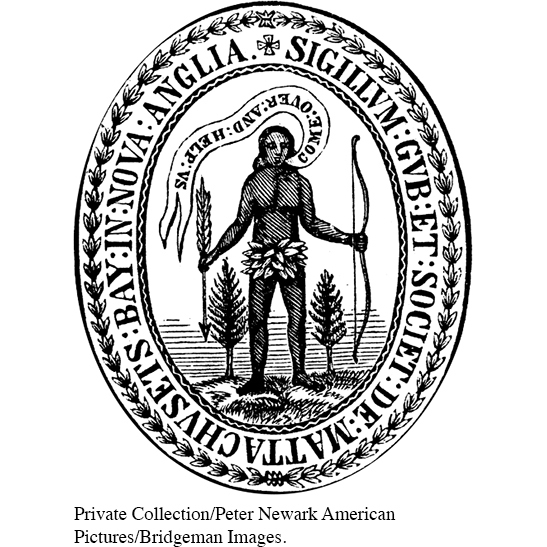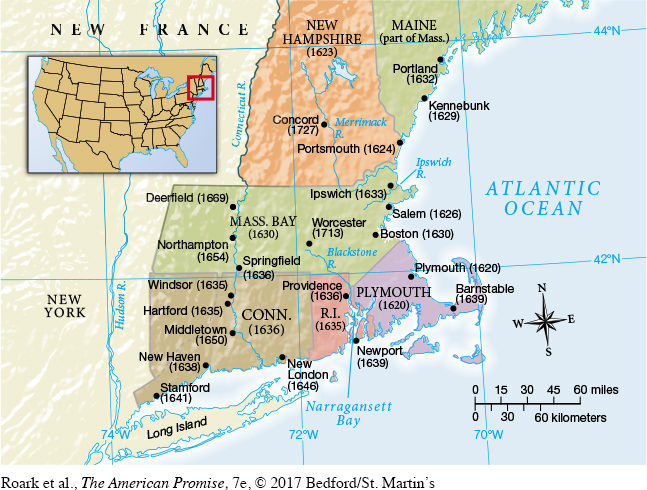The American Promise: Printed Page 82
The American Promise, Value Edition: Printed Page 76
The American Promise: A Concise History: Printed Page 87
The Founding of Massachusetts Bay Colony

In 1629, shortly before Charles I dissolved Parliament, a group of Puritans obtained a royal charter for the Massachusetts Bay Company. The charter provided the usual privileges granted to joint-
The American Promise: Printed Page 82
The American Promise, Value Edition: Printed Page 76
The American Promise: A Concise History: Printed Page 87
Page 83To lead the emigrants, the Massachusetts Bay Company selected John Winthrop, a prosperous lawyer and landowner, to serve as governor. In March 1630, eleven ships crammed with seven hundred passengers sailed for Massachusetts; six more ships and another five hundred emigrants followed a few months later. Unlike the Separatists, Winthrop’s Puritans aspired to reform the corrupt Church of England (rather than separate from it) by setting an example of godliness in the New World. “For England’s sake they are going from England to pray without ceasing for England,” wrote one Puritan emigrant. Winthrop and a small group chose to settle on the peninsula that became Boston, and other settlers clustered at promising locations nearby (Map 4.1).

In a sermon to his companions aboard the Arbella while they were still at sea—
That belief shaped seventeenth-
The new colonists had “all things to do, as in the beginning of the world,” as Winthrop’s son wrote later. Unlike the early Chesapeake settlers, the first Massachusetts Bay colonists encountered few Indians because the local population had been almost entirely exterminated by an epidemic. Still, many of the colonists succumbed to diseases. During the first year, more than two hundred settlers died, including one of Winthrop’s sons and eleven of his servants. Winthrop himself remained confident and optimistic. He wrote to his wife that “I like so well to be heer as I do not repent my comminge. . . . I would not have altered my course, though I had forseene all these Afflictions.” And each year from 1630 to 1640, ship after ship followed in the wake of Winthrop’s fleet, bringing more than twenty thousand new settlers.
Often, when the Church of England cracked down on a Puritan minister in England, he and many of his followers moved together to New England. Smaller groups of English Puritans moved to the Chesapeake and elsewhere in the colonies, including New Amsterdam (present-
The occupations of New England immigrants reflected the social origins of English Puritans. On the whole, the immigrants came from the middle ranks of English society. The vast majority were either farmers or tradesmen. Indentured servants, whose numbers dominated the Chesapeake settlers, accounted for only about a fifth of those headed for New England. Most New England immigrants paid their way to Massachusetts. They were encouraged by the promise of bounty in New England reported in Winthrop’s letter to his son: “Here can be no want of anything to those who bring means to raise [it] out of the earth and sea.”
In contrast to Chesapeake newcomers, New England immigrants usually arrived as families. In fact, more Puritans came with family members than did any other group of immigrants in all of American history. Unlike immigrants to the Chesapeake, women and children made up a solid majority in New England.
The American Promise: Printed Page 82
The American Promise, Value Edition: Printed Page 76
The American Promise: A Concise History: Printed Page 87
Page 85As Winthrop reminded the first settlers in his Arbella sermon, each family was a “little commonwealth” that mirrored the hierarchy among all God’s creatures. Just as humankind was subordinate to God, so young people were subordinate to their elders, children to their parents, and wives to their husbands. The immigrants’ family ties reinforced their religious beliefs with the interlocking institutions of family, church, and community.
REVIEW What was a “little commonwealth,” and why was it so important to New England settlement?